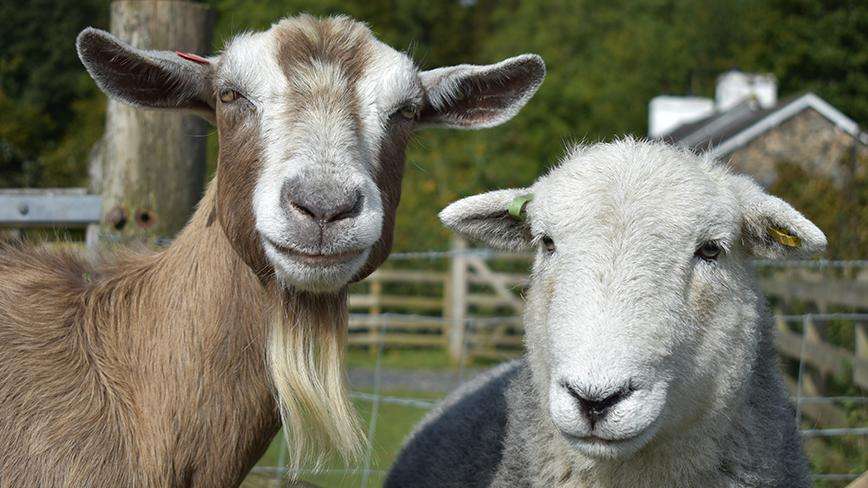ADVOCATING FOR GOAT AND SHEEP PRODUCTION IN THE FACE OF CLIMATE CHANGE
ABSTRUCT
This paper intends to (a) highlight the effects of climate change in ruminant production, (b) to specifically highlight the effects of Climate Change on rangelands as well as to(c) showcase the importance of goat and sheep production as opposed to cattle farming in Botswana in the face and age of Climate Change.
Over the past decade, the global village witnessed a rapid increase of global warming related negatives such as – decreasing water supplies mostly due below normal rainfalls, Botswana is a perfect example of a country affected as the city’s dam that supplied the greater Gaborone has since failed with a current water level of 1.4 according to the September 15, 2015 update by Water Utilities. These has since led to consequent water rationings, which sometimes spill over into days of no water for residents of the greater Gaborone area.
Other effects of climate change include but are not limited to (a) the encroachment of shrubs into grasslands, rendering rangeland unsuitable for domestic livestock grazing, (b) increased heat stress in humans and other mammals, (c) vegetation die-off due to drought, (d) increased damages from floods and (e) increased temperatures; Botswana’s temperature is expected, if it hasn’t already, to increase by 1 degree Celsius this year.
The world at large is experiencing climate change in one way or the other, no nation is immune to this development. Hence the global village have since taken interest in climate change issues. The first or the third world, developed or developing, at an advantage or at a disadvantage, nations have joined hands in a bid to come up with sustainable means of reversing the damage caused by Green House Gases, overgrazing, and deforestation among other earth crippling factors that are considered encouragers of climate change. Last year saw the Conference of Paris (COP20) attended by 15 000 official delegates. Alongside it were more than 400 conferences in which new research projects and initiatives were presented.The Sustainable Innovation Forum 2014 was the largest commercially-focused event during COP20, attracting high profile speakers, celebrities and over 500 pre-approved delegates representing private sector, government, NGO, UN agencies and civil society. During the two weeks of COP20, over 140 press conferences were held and more than 900 journalists from around the world covered the international event. From this, one can appreciate the seriousness and urgency with which climate change needs to be mitigated.
Thus said this paper, advocates for goat and sheep production over cattle rearing in the face of climate change in Botswana, given that cattle numbers tend to dwindle during drought periods as rangeland feed shrinks while the number of goat rises and that of sheep tends to remain steady. Climate change is not going away anytime soon, the expected loss of cattle due to effects of global warming in a country already declared ‘drought’ late this June, should therefore alert livestock farmers to the necessity of dominantly but not entirely shifting to goat and sheep production before disaster strikes.
INTRODUCTION
As a result of carbon dioxide and other “green house” gases, the planet is expected to progressively warm up significantly during the next decades. Further straining the ecosystem, animal agriculture and rangelands. (P. M. Kgwatalala et.al)
It is anticipated that climate change in Botswana will cause significant changes in rangelands and livestock – Climate change is expected to affect species diversity, type, distribution and composition and the effect will be felt by those who depend on the land.
Cattle will be the most affected ruminants in Botswana.
It is clear that cattle has been predominate in Botswana during the 1961-98 period, except for year 1993 when goat and cattle numbers were about the same, the sheep population though was consistently lower. The annual growth rate for cattle was 1.6 percent, goat 3.9 percent and sheep 1.3 percent around this period. The decline of cattle was induced by drought while the high growth of goat population during the 1977-91 period was witnessed despite the occurrence of successive droughts of 1982 through 1987.(Enhancing Sheep and Goat Production in Botswana)Hence the advocacy for goat and sheep rearing.
Furthermore, the quality and quantity of forage in rangelands will decline and farmers will be forced to reduce livestock numbers to align livestock numbers with the amount and quality of forage.Alternatives such as feedlotting are dependent on the management and economics of the operation however, most traditional/rural farmers have no certificates, diplomas, let alone a degree – the knowledge to undertake feedlots fruitfully.
As far as vegetation is concerned again, due to lack of water and the subsequent moisture dry-off, some plants will allocate more photosynthetic products towards the production of roots and less towards the production of leaves. The smaller leaf area and stomatal density reduce both water loss and growth rates hence lower production of forages.The drier environment will reduce the activity of decomposers and organic matter will accumulate on the soil surface, reducing the availability of nutrients to plants as well as total production by plants.The above scenario will reduce food and nutrients available to consumer groups including livestock and wildlife. (P. M. Kgwatalala et.al)
In the long run production by all consumer groups will suffer and livestock numbers and productivity will decline. Heat stress will also put an extra burden on the animals making it harder for them to fight off diseases.
According to, P. M. Kgwatalala et.al, Global warming will result in an increase in temperature and a reduction in rainfall and some diseases and parasites may retreat from areas they are currently endemic. Livestock production cannot be carried out without a reliable water supply. Cattle must consume according to season 10-40 liters of water.Hence the suggestion that it is necessary to consider changing the species of animals kept to those better suited to the changed forage compositioni.e Goats and Sheep.
REASONS FOR ADVOCATING FOR GOAT AND SHEEP PRODUCTION OVER CATTLE REARING IN THE FACE OF CLIMATE CHANGE
According to C. Dvendra and G. B. McLeroy, on the Origin and History of domestication of the goat, “the goat was probably the first animal to be domesticated around 900-700 BC. This long association between goat and humans indicates the variety of functions the goat can provide. Like many other domestic animals, the goat was first used for meat production, but it also preceded the cow as a dairy animal. Goats are small, hardy animals and they are easier to maintain than cattle. Hence this paper calls on local farmers to consider their first love – the small ruminant. Goat and sheep, though goats are browsers and sheep are grazers and though sheep will be affected a little more by lack of vegetation, the two ruminants have their undisputable advantages over cattle in the wake of climate change.
In reference to Geoff Pollott et al.,C. Dvendra et al. and A. A. Aganga et al. the following are true for both goats and sheep:
- Goat and sheep mature early, obviously unlike cattle.
- They can be handled by women and children, because they are small in body size.
- They are not capital intensive and can be afforded by poor families, they are considered the poor man’s cow.
- Tswana breeds are hardy, disease resistant –heart water, parasites.
- Human populations are growing rapidly creating a significant and increasing demand for additional animal protein foods. Farmers will not lack a market.
- Roughage feeds and crop by-products unsuitable for human consumption, can be processed by the animals into desirable human food.
- It is easier to increase the population of small ruminates like goats and sheep rather than large ruminates such as cattle.
- Because farm capital investments is low, small land required, reproductive turnover is high and both species can be managed easily by family labour.
- Goat meat is usually leaner than mutton and the distribution of the fat on the carcass differs.
- In sheep, fat is distributed throughout the carcass though there maybe concentrations in the tail of some breeds, in the rump.
- Goat milk is nutritionally similar to cow’s milk but the high proportion of small fat globules facilitates easy digestion. It may also possess some anti-allergenic properties.
- The composition of sheep milk differs in that it possesses a higher content of fat, crude protein and non-fat solids.
- Cooking fat is considered to impart flavour to other foods
- Useful source of protein for the low income families
- High reproductive rate (multiple births are common)
- Short gestation period (5 months, can kid/lamb twice annually)
- Milk product delicacies such as cheese, butter, yoghurt will not cease with the small ruminant preference.
CONCLUSION
All points discussed, it is rather apparent that goat and sheep production can play a major role in poverty eradication – at a time when Botswana’s main two GDP contributors (Beef and diamonds) are at the brink of failing the nation. However farmers should be cognisant of the fact that some agricultural practices such as over grazing among others also contribute to climate change, lest they worsen a situation by trying to solve another. Mindful agricultural practices should hence be researched and implemented regardless of the size of the alternative ruminates suggested.
REFERENCES
- Dvendra and G. B. McLeroy (1982) Goat and Sheep Production in the Tropics by, Longman Group UK
- H. French (Rome 1970, FAO 1970) Observations on the Goat, Food and Agriculture Organisation of the United Nations
- A. Aganga, R. G. Chabo, M. Kgosimore, M. Letso and U. J. Omphile (1999): Enhancing Sheep and Goats Production in Botswana, Gaborone, Government Printer
Geoff Pollott and R. Trevor Wilson, (Rome 2009) Sheep and Goats for Diverse Products and Profits, Rural Infrastructure and Agro-Industries Division Food and Agriculture Organization of the United Nations
http://www.cop21paris.org/about/cop21: Accessed on Sept 17,2015





